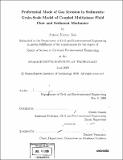Preferential mode of gas invasion in sediments : grain-scale model of coupled multiphase fluid flow and sediment mechanics
Author(s)
Jain, Antone Kumar
DownloadFull printable version (43.08Mb)
Other Contributors
Massachusetts Institute of Technology. Dept. of Civil and Environmental Engineering.
Advisor
Ruben Juanes.
Terms of use
Metadata
Show full item recordAbstract
We present a discrete element model for simulating, at the grain scale, gas migration in brine-saturated deformable media. We rigorously account for the presence of two fluids in the pore space by incorporating forces on grains due to pore fluid pressures, and surface tension between fluids. This model, which couples multiphase fluid flow with sediment mechanics, permits investigating the upward migration of gas through a brine-filled sediment column. We elucidate the ways in which gas migration may take place: (1) by capillary invasion in a rigid-like medium; and (2) by initiation and propagation of a fracture. We find that grain size is the main factor controlling the mode of gas transport in the sediment, and show that coarse-grain sediments favor capillary invasion, whereas fracturing dominates in fine-grain media. The results have important implications for understanding vent sites and pockmarks in the ocean floor, deep sub-seabed storage of carbon dioxide, and gas hydrate accumulations in ocean sediments and permafrost regions. Our results predict that, in fine sediments, hydrate will likely form in veins following a fracture-network pattern. In coarse sediments, the buoyant methane gas is likely to invade the pore space more uniformly, in a process akin to invasion percolation, and the overall pore occupancy is likely to be much higher than for a fracture-dominated regime. These implications are consistent with laboratory experiments and field observations of methane hydrates in natural systems.
Description
Thesis (S.M.)--Massachusetts Institute of Technology, Dept. of Civil and Environmental Engineering, 2009. Includes bibliographical references (p. 67-79).
Date issued
2009Department
Massachusetts Institute of Technology. Department of Civil and Environmental EngineeringPublisher
Massachusetts Institute of Technology
Keywords
Civil and Environmental Engineering.